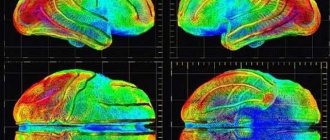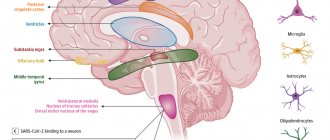Rabies is an incurable disease that develops rapidly, and the main sources of infection are wild animals. However, the pathology is dangerous even for those cats that do not leave the house.
We will learn how to protect your pet from this serious disease, how to recognize the first signs of infection, and what to do if infection does occur.
The causative agent of the disease
An RNA virus, it is distributed on many continents. The pathogen has average resistance to high temperatures, is destroyed in an hour at 54-60o C, and dies instantly at 100o C. It is not resistant to low temperatures and can be stored frozen for several months, but it dies if repeatedly frozen and thawed.
The virus cannot survive outdoors. It also dies quickly in slightly alkaline or slightly acidic environments, but can survive more than a day in the gastric juice and several hours in the intestines, so sometimes cats become infected by eating rodents that have died from rabies. But rabies is transmitted from a cat to a person only through a bite.
Rabies vaccination for dogs: side effects
When sending a dog for rabies vaccination, it is important for the owner to understand that a foreign substance will be introduced into its body and the appearance of any complications after vaccination should not be surprising.
After vaccination the following are possible:
- increase in body temperature
- salivation
- bowel disorder
- swelling of the ears and eyes
- behavior change
Allergy is a common reaction to rabies vaccine. It manifests itself in the first 5 to 10 minutes after the injection. The veterinarian will immediately notice its first symptoms and stop the attack by administering an antihistamine.
IMPORTANT: Side effects are rarely observed when using foreign inactivated vaccines ( Nobivak, Eurikan ).
Nobivak - rabies vaccine
A variant of the norm is the appearance of bumps or lumps on the dog's skin at the site of vaccine administration. This reaction is not considered a complication and goes away on its own over time.
If at the time of vaccination the dog was already infected with rabies, but symptoms of the disease have not yet appeared, after vaccination the animal will become ill or even die.
A dog will die from rabies if it was already infected at the time of vaccination.
Distribution and pathogenesis
The pathogen is transmitted through bites, after which the first sign may be itching in the bite area. The virus multiplies on the cells of the nervous tissue, and it is transmitted through them, gradually rising to the central nervous system (the spine and then the brain). In addition, the pathogen can be spread through the blood or lymph flow, but this is only an additional method.
When a cell is infected, the virus releases neurotoxins, which cause the symptoms characteristic of rabies. The pathogen affects all nerves, not just the central nervous system; in particular, it affects the nerve ganglia of the salivary glands, which causes severe salivation. At the same time, it penetrates the salivary glands themselves.
The incubation period in cats lasts from 3 days to 3 weeks, and in humans from 10 days to 2 months. The virus is detected in saliva 8-10 days before the first symptoms appear. At the same time, there are cases when the incubation period was reduced to one day for a cat and up to 5 days for a person, or, conversely, extended by several years.
Routes of transmission
The natural reservoir of the rabies virus is wild animals (wolves, foxes, martens, hedgehogs, raccoons, bats or field mice). Domestic cats can become infected from them. Carriers of the infection are most dangerous in the last 10 days of the incubation period, as well as during the manifestation of its symptoms. During this period, the pathogen reaches their salivary glands.
The pathogen enters the body of a healthy cat through a wound formed after the bite of an infected animal. Microbes multiply at the injection site. First, the soft tissue around the affected area is affected, and then the nerve cells.
Rabivirus enters the central nervous system via a neurogenic route (along nerve fibers) and ascends along the spinal cord to the brain, where it causes irreversible damage. It increases the excitability of nerve cells, gradually destroys them and causes paralysis.
Dead neurons are replaced by Babes-Negri bodies. Pathological changes lead to disruption of innervation and dysfunction of various organs and tissues.
There are the following routes of infection:
- bite of a sick animal;
- contact with saliva on damaged areas or mucous membranes;
- scratching;
- contact with objects on which saliva of infected animals is present;
- eating sick animals.
In this way, not only pets, but also people can get sick.
After reaching the brain, the rabies virus spreads throughout the body. It accumulates in the salivary glands. Then the animal spreads the infection further through its saliva. The pathogen does not spread through blood, urine, lymph and milk.
Probability of infection
Even after being bitten by a cat infected with rabies, the chance of getting the disease is 30-50%. This is due to the fact that the virus remains on the wound itself for some time and does not penetrate inside; therefore, if a person has disinfected the wound, the likelihood of infection is reduced. In addition, your own immunity also has an impact. In addition, the pet does not always manage to bite through human clothing.
If a person is scratched by a cat, then the chances are almost zero. The virus does not survive in open air, including on skin or claws. But at the same time, you need to understand that the saliva of a sick animal often floods the entire lower jaw, dewlap, and sometimes gets onto the front paws.
Contact of saliva on the front paw with an open wound (from a claw) can cause infection. But in this case, the virus will be weakened by exposure to UV rays, and the contact will last a fraction of a second, so the amount of pathogen that penetrates will be minimal. So, although infection through a scratch is theoretically possible, this never happens in practice.
Definition of disease
The pathology is so ancient that mentions of rabies are found in annals dating back thousands of years BC.
No matter how medicine has developed, there is still no medicine that can cure an affected person or animal. The danger is that the virus that causes the disease is constantly mutating, adapting to new living conditions.
Rabies is an infectious disease transmitted to healthy individuals through saliva (by a bite or simply by close contact). Skin wounds, abrasions, and mucous membranes are excellent “gateways” for the virus to enter the body.
The Russian name for the pathology describes the violent state of the infected. The official medical term Rabies virus translates as “phobia of water,” which corresponds to another sign of rabies.
When infected, the central nervous system is first damaged, causing inflammation of the brain (spinal and brain).
The prognosis is disappointing: rabies is fatal.
Pets transmit the virus to each other. But initially it comes from the outside - from stray cats or dogs. They, in turn, get a dangerous disease from representatives of wildlife - rodents, wolves, foxes, raccoons, bats.
The virus does not act selectively. He doesn’t care what breed of animal, what age the pet is. It’s just that cats weakened by disease, elderly pets, and small kittens have a low threshold of resistance, and they have it the worst of all.
Symptoms in cats
Cats suffer from a violent form of rabies. A day before the appearance of a clear clinical picture, pets change in character, becoming either too sociable or too withdrawn. This period is dangerous because the cat’s saliva already contains the virus, but the symptoms are not obvious.
Then comes the stage of excitement. At the same time, they behave extremely aggressively, attacking humans (and even the owner), dogs, and any other animals. They frantically tear up chairs, sofas, carpets, ground and floors, and gnaw on all objects in sight, including inedible ones. A particular danger to humans is that cats often attack silently, so there is no way to prepare and fight back.
The last stage of the disease is paralysis and death. First, there is an alternation of excitement and depression, gradually the periods of depression stretch out and become more frequent. At the same time, paralysis spreads to the entire body, first it affects the lower jaw and larynx (the cat cannot swallow), then the animal’s legs fail. Death occurs due to paralysis of the respiratory center or heart.
Signs of the disease
The clinical picture appears after the incubation period. Its duration in pets depends on the following factors:
- Age. In an adult domestic cat, symptoms of infection appear after 3–6 weeks, and in a kitten after 5–7 days.
- Concentration of viral agents. The higher the level of rabbivirus, the faster the signs of rabies will appear.
- Area of the affected area. The rate at which clinical signs appear depends on the location and depth of the bite. The further the affected area is from the head, the longer it will take for clinical signs to appear. If there are many bites and they are deep, then the incubation period is reduced.
Another important factor is the state of the immune system.
Important! A vaccinated cat has a better chance of avoiding death from rabies. The vaccine allows you to develop specific immunity to the rabivirus.
The first signs of pathology appear 7–14 days after the bite. Sometimes the period of calm lasts up to 6–12 months.
Infected cats exhibit atypical behavior. Unsociable pets require increased attention, while friendly ones show aggression and withdraw.
Sick cats suffer from eating disorders. They lose their appetite, they try to swallow inedible objects, vomiting and diarrhea occur.
Severe itching appears on the affected area, which owners often confuse with parasites. In later stages, the cat does not want to drink, suffers from painful spasms, profuse drooling, and paralysis.
The clinical picture depends on the form of rabies:
- classical;
- paralytic or silent;
- atypical.
There is an abortive form of infection, but it has not yet been studied enough. In most cases, it ends on its own. But sometimes the disease may re-develop after 14 days. Then the cat dies after 2–4 days. Full recovery after relapse occurs in 2% of cases.
Classic shape
This dangerous cat disease often occurs in its classic form. It manifests itself as a dramatic change in behavior. The duration of the disease is from 5 to 12 days.
Veterinarians distinguish 3 stages of classic rabies:
- Stage 1 lasts 1–2 days. It all starts with behavioral changes. The cat becomes anxious, fearful, detached, indifferent, looking for a secluded place. In rare cases, the pet becomes overly excited, demands affection from the owner, and becomes active in every possible way. He may appear to be hallucinating (visual and auditory). The cat eats less or refuses food completely, loses weight, suffers from shortness of breath, nausea, vomiting, and diarrhea. Her eyes cross, her pupils become enlarged, and she cannot move her mustache. It is difficult for a cat to swallow, a lot of saliva is released, the muscles of the pharynx are weakened, the neck is stretched, it makes grasping movements, the voice becomes hoarse. The muscles of the limbs weaken, tremor (shaking) is observed, and the gait becomes unsteady. Due to severe itching, the cat constantly scratches and gnaws at the bite site, further injuring it, and stops licking its fur, which is why it takes on a sloppy appearance.
- Stage 2 lasts 3 days. The animal becomes irritable and aggressive. The cat is spinning in one place, trying to bite everything that touches its face. She can attack the owner or a stranger, other pets or even objects. In a fit of rage, a cat can injure itself (jaw fracture, teeth knocked out). Don't try to calm her down, it's dangerous. The cat is dripping saliva from its mouth, foam appears, and is afraid of light and water. Muscle spasms, epileptic attacks, and paralysis are observed. This is manifested by excessive arching of the back or paws. The muscles of the pharynx continue to weaken, causing the lower jaw to droop and the tongue to fall out. The cat cannot eat or drink. Constriction of the pupils alternates with strabismus, and periods of aggression with calmness and depression. In later stages, periods of calm become shorter.
- Stage 3. The muscles in the back of the body completely fail. The cat moves with the help of its front paws, while its hind paws drag. Due to paralysis, the genitourinary system and the final intestine fail. Weakness and exhaustion lead to the cat falling into a coma.
The cat dies 1–3 days after the onset of stage 3 rabies. Due to paralysis, the respiratory organs and heart fail. The pathology develops quickly, since the brain stem is affected almost immediately after the entry of the rabivirus.
Silent form
With this form of rabies, the sick cat behaves calmly and apathetically. She salivates excessively and has difficulty swallowing due to paralysis of the pharyngeal muscles. The cat refuses its usual food, but tries to eat inedible objects. This leads to various digestive disorders: diarrhea, black stools with a strong odor, abdominal pain, vomiting.
Symptoms of the silent form of rabies:
- unsteady gait;
- decreased or loss of appetite, changes in eating habits;
- blank look;
- freezing in place, loss of orientation;
- vomit;
- blood in stool.
The danger of this form of infection is that it is easily confused with other diseases. Often, owners think that their cat is choking due to laryngeal paralysis. The lower jaw droops, the tongue falls out. People try to help a pet by looking into its mouth, which increases the risk of a bite and infection.
Paralysis first affects the lower jaw, then the hind legs, torso and forelimbs. Death occurs due to paralysis of the respiratory organs and heart. With the silent form of rabies, the cat lives no longer than 2–4 days.
Atypical form
This variant of rabies is less common than others. It is difficult to identify, since the symptoms are mild, and periodically the cat’s condition improves. Behavioral changes and neurological disorders may be absent in the initial stages. Sometimes there is even no paralysis.
The atypical form of rabies is manifested by refusal to eat, drink, and excessive salivation. There are symptoms of diseases of the digestive organs: loss of appetite, nausea, vomiting, diarrhea mixed with blood, sudden weight loss. The cat becomes passive, its body is exhausted, convulsions periodically appear, and the muscles atrophy.
The owners do not even suspect that the animal is infected with a deadly virus. They do not keep their distance, so the likelihood of infection increases. This form of infection has a protracted course. A cat can suffer from its manifestations for about a year.
Symptoms of abortive rabies may resemble any of the above. It differs in that during paralysis, the signs of pathology suddenly disappear, and the pet’s condition returns to normal. But, as mentioned, a relapse is possible, after which the cat most often dies within 2–4 days.
Signs in humans
Rabies occurs in humans, just like in all other animals. First, itching appears in the area of the bite, pain and muscle cramps along the nearest nerves are possible. Usually, 1-3 days before a vivid clinical picture, a person is worried about hidden anxiety, causeless fear or severe melancholy.
Then clear symptoms of rabies develop:
- Hydrophobia is the inability to take a sip of water due to panic fear; the muscles of the pharynx and larynx contract convulsively even at the sound of pouring water.
- Photophobia is fear and pain in the eyes from light, even not too bright. Man hiding in dark rooms
- Acousticophobia is panic and fear from any sounds, sometimes even minor noise causes a strong negative reaction.
Paralysis gradually develops. First they touch the facial muscles, then move to the arms and legs. Finally, the paralysis spreads to the vascular and respiratory nerve centers, resulting in death.
Forms of rabies
One of the signs that a pet has become infected with rabies is its desire to “change its surroundings.” So the dog tries to run away from the house.
But in order to understand that the animal has actually received a dangerous virus, you should study all possible variants of rabies.
| Variety | Peculiarities |
| Violent | This is a classic form consisting of 3 stages. Its description is given in table 1 |
| Atypical | It differs from the clinical variant in the absence of an excitation stage. There are no characteristic symptoms, but the dog may develop gastroenteritis, leading to exhaustion |
| Abortive | This form is rare (no more than 2% of all cases). It manifests itself in the fact that, before it has time to move into the 2nd phase, the disease subsides and the dog is cured |
| Remitting | This type of disease resembles a swing. The animal supposedly begins to recover, then signs of rabies return. Such cycles are observed several times with short intervals, but in the end the dog still dies |
| Depressed | The silent form of rabies is similar to the third stage of the classic disease. Within 2-4 days, paralysis affects the dog's hind legs, throat and lower jaw |
Expert opinion
Makarenko Svetlana Igorevna
Practicing veterinarian, 15 years of experience.
Despite the fact that there is an abortive form of rabies, the owner should not console himself with hopes that his pet will be cured. The disease is insidious, it kills an infected dog in a few days.
Prevention
Preventive measures are divided into two groups: among animals and among people.
Prevention of the spread of rabies in animals:
- catching stray animals;
- shooting wild animals near large populated areas;
- annual vaccination of domestic dogs and cats;
- walking dogs on a leash and muzzle, walking cats on a leash.
Preventive measures - vaccination - among people are carried out only for risk groups. This category includes veterinarians, representatives of the animal control service, and dog handlers.
Many viral diseases are characteristic of only one species of mammals, however, there is a disease that is dangerous for all warm-blooded animals and humans. Rabies is a disease that affects the brain and causes death.
In stereotypical ideas, the most scary thing is to encounter an infected dog, however, you can become infected with rabies from a cat, rodents and wild animals.
Diagnosis of the disease
If you find scratches or wounds on your pet’s body, you should not wait for obvious signs of infection. After a cat bites another animal, you should immediately call a veterinarian at home .
To diagnose the disease, the animal is tested for rabies. It is necessary to distinguish it from another disease with similar symptoms - Aujeszky (pseudorabies).
If the result is positive, the cat is immediately euthanized - rabies cannot be treated. After the animal dies, its brain is examined to make a final diagnosis.
What is rabies in a cat?
The course of the disease in cats is not much different from the course of the disease in other animals. The onset of the disease is associated with the entry of a virus into the body, which begins its journey to the brain through the blood and lymph.
IMPORTANT! The pathogen enters the body through the saliva or blood of an infected animal. A cat only needs to eat a sick rodent or fight with an infected animal to become infected with the virus.
This pathogen is persistent and persists for a long time in the corpses of dead animals. In the cold it remains active for 2 years, but heating destroys this agent. Also, phenolic compounds, alkaline solutions and formaldehyde inhibit the effect of the virus.
Understanding what rabies is in a cat is quite simple: you need to understand the mechanism of action of the virus and the consequences of infection.
The agent itself is divided into 2 types:
- Urban. An aggressive pathogen that has a short incubation period and leads to rapid death.
- Forest. Wild animals are susceptible to it, however, over generations they develop adaptability: foxes, wolves, raccoons remain carriers, but do not show manifestations of the disease. However, the bite of such an animal is also dangerous for domestic animals, including cats, which are allowed to roam freely.
There are 3 forms of the disease in cats:
- quiet;
- atypical;
- violent.
A quiet course is characterized by the absence of an aggressive phase. This form is characterized by the most rapid progression - the animal falls into apathy, then paralysis occurs, respiratory depression occurs, and the pet dies.
Atypical rabies is extremely rare. It is difficult to recognize due to the almost complete absence of symptoms. Attentive owners may notice the animal's drowsiness, lethargy, and lack of interest in games. With this form, an adult can live for several months. According to some studies, this form is sometimes curable.
The violent form is the most famous and widespread. The disease has 3 stages, and the second is extremely dangerous for others. Mechanism of pathology:
- Stage of melancholy. First, some signs of behavior change appear: an increased need for affection or, conversely, a desire to hide in dark corners. Next, damage to the nervous system manifests itself, consisting in uncontrolled movements of the jaws. Subsequently, the desire to eat inedible objects develops, salivation increases, and vomiting develops.
- Excitement stage. The cat demonstrates uncontrollable aggression towards people, animals and even objects. It is impossible to recognize the beginning of the attack. When bitten by hard objects, jaw fractures occur and teeth crumble. Once outside, a sick individual can run 50 km, spreading the virus along the way.
- Stage of depression. The violence passes, paralysis of the larynx develops, preventing drinking water and eating. Later, the hind limbs fail, and the cat has difficulty moving. The final hours are coma. Having fallen into it, the animal dies from exhaustion or respiratory failure.
Atypical forms
If with the violent form everything is extremely clear, then with other options the situation is more complicated.
The atypical manifestation of the disease prevents many owners from identifying it with rabies. This makes the infection even more dangerous for others.
Quiet and silent
The disease lasts from 2 to 4 days, during which the pet becomes overly intrusive. The animal does not show any signs of aggression; on the contrary, it requires plenty of affection.
People tend to respond to such behavior with responsiveness.
They take the cat in their arms, stroke it, and sometimes kiss it. But the pet may already have the rabies virus in its saliva, which poses a danger to humans.
Atypical
At first, this form is similar to the violent one, but the disease is more complicated. The cat develops enteritis and gastritis, accompanied by severe vomiting and bloody diarrhea. This exhausts the pet, and it quickly loses strength.
The atypicality lies in the fact that after some time relief occurs, and the symptoms of rabies are perceived as signs of food poisoning. This phase is short-lived and is followed by paralysis, leading to the death of the animal.
Nuances of the incubation period
Once in the blood, the virus does not become active immediately. The incubation period usually lasts 1-1.5 months, however, already after 8 days the pet is contagious. The appearance of symptoms of the disease earlier than after 4 weeks occurs in pets with low immune defense.
This:
- kittens with undeveloped immunity;
- allergy sufferers;
- elderly and weakened pets;
- cats with chronic diseases;
- animals recovering from injuries and surgeries
IMPORTANT! A strong immune system can delay the onset of the disease. In veterinary practice, cases have been recorded where the latent period lasted up to 1 year.
Also, the duration of incubation of the pathogen is influenced by the location of the bite site or the penetration of saliva through the wounds. The virus strives to reach the brain, simultaneously affecting the nervous system and organs. When the agent enters through damaged skin on the head or neck, the disease develops much faster. The amount of virus that has entered the pet’s body also matters.
Post-mortem diagnosis
Laboratory examination of a living dog for rabies is not carried out; they are content with the observed symptoms.
To make a final diagnosis, the brain of an already deceased animal is examined.
Babeshi-Negri test
After removal, the brain is examined. If the animal was indeed infected, characteristic bodies are found in the sections. But this diagnostic method is not always accurate; there is an error of up to 50%. Therefore, if you receive a negative result, you should not exclude the possibility that your dog may be infected with rabies.
Confirmation is immunofluorescence analysis of sections, which allows the identification of antigens.
Bioassays
Maximum accuracy in making a diagnosis will be achieved by testing on laboratory mice.
They are injected with a suspension made from the brain tissue of a deceased animal. Observations are carried out over 28 days. This allows you to determine the form of the disease that affected the dog.
Routes of human infection
A person can become infected with rabies from an indoor or outdoor cat in several ways. The main routes of infection are bites and scratches, as well as the saliva of a sick pet coming into contact with damaged skin.
IMPORTANT! The likelihood of infection directly depends on the extent of the damage and its location. If the skin of the head and face is injured, the risk of getting sick increases significantly.
Preventive measures must be taken on the first day, so if there is a minimal probability of the animal having the disease, you should immediately consult a doctor and begin a course of injections.
If bitten by a cat
The main danger of animal rabies for humans is that the pet becomes infectious before the clinical picture of rabies appears. Most often, an owner or volunteer who feeds stray animals becomes infected if they are bitten by a cat, unaware that they are interacting with the carrier.
Careless games or the specific nature of the individual can cause not gentle biting, but a full-fledged bite with the fang penetrating through all layers of the skin. Blood comes out and mixes with the saliva of the infected pet, resulting in infection.
The risk of infection increases if the pet begins to lick the wound. A larger amount of saliva increases the number of viral agents entering the human body.
If scratched by a cat
Scratches themselves do not pose a danger to humans. However, there is still a chance of infection if a cat scratches. This happens under the following conditions:
- the lower parts of the limbs are damaged, the pet’s blood may get into the scratch;
- accidental contact of cat saliva in the area of injury;
- independent treatment of open wounds of an animal with damaged skin of the hands.
Other routes of infection
Other routes of infection include contact of blood and saliva with human mucous membranes. This occurs after contact with a sick cat and ignoring disinfection measures. Also dangerous is allowing the pet to eat from the owner’s plate and feeding it with its own spoon. In addition to the fact that human food is harmful to pets, the risk of contracting the virus cannot be completely ruled out.
Another route of infection is licking the face or hands. The rough tongue of cats causes microcracks in human skin, through which saliva containing the disease agent enters.
Can you get rabies from a cat?
Rabivirus, transmitted by contact, is very dangerous for humans. The owner of an infected cat is especially at risk of getting sick. The pathogen can be transmitted through a bite or scratch on the skin. If the saliva of a sick cat gets on the damaged areas, the person will also get sick.
Immediately after the incident, you need to wash the bite site with water and laundry soap. Then the wound should be wiped with an antiseptic and a visit to the traumatologist should be made. Next, the infected person is prescribed a course of injections and antibiotics.
How to recognize a sick cat
Knowing the somatic and behavioral signs of rabies, a sick cat can be recognized by the following manifestations:
- an active animal becomes apathetic, hides, avoids society;
- the pet shows increased, unusual affection, tends to lick its face and hands;
- nervous movements of the jaws appear, as if the pet is trying to catch a flying insect;
- appetite changes, the cat shows increased interest in inedible objects;
- there is a strong flow of saliva;
- vomiting begins, which is regular;
- the cat rushes at visible objects for no reason;
- the animal chews objects with such force that it breaks teeth, but does not suffer pain or discomfort;
- a domestic pet tends to run away, while a street pet is in constant motion;
- complete refusal of food and water;
- development of paralysis.
This symptomatology manifests itself at various stages of the disease, however, if alarming signs appear, you should immediately consult a doctor.
Immediately after a bite, your pet can be saved if you take it to the clinic, get tested and leave it in the hospital, limiting its movements. Quarantine lasts about 2 weeks.
Unfortunately, it is not always possible to take your pet to a doctor immediately after a suspicious injury. Therefore, in this case, a guaranteed accurate diagnosis is established only through post-mortem analysis of the brain. However, in order to protect other people and animals, at the slightest suspicion, the pet must be isolated and shown to a specialist.
Diagnosis confirmation
Every person should know how different forms of rabies manifest themselves in cats. If you suspect an infection, you need to act according to the following plan:
- Isolate the cat in a special box or separate room.
- It is prohibited to call a veterinarian or carry out diagnostics on your own.
- Prepare a veterinary passport with information about vaccinations.
Unfortunately, it will not be possible to confirm the diagnosis during life, since there are no specific tests. Laboratory blood tests are useless in this case, because there is no rabivirus in it. Pathological changes are discovered after death during an autopsy: Babes-Negri neoplasms (bubbles with liquid), multiple hemorrhages in the brain, stomach, exudate in the spinal canal.
Important! The signs of rabies are similar to other diseases in which the membranes or substance of the brain become inflamed.
Important diagnostic signs:
- bites on the body;
- behavioral changes;
- reaction to stimuli, such as light, water, touch;
- salivation;
- changes in appetite, digestive disorders;
- impaired coordination of movements.
The cat is quarantined for 10–30 days. After the specified period, she dies or recovers (if the cause of the illness was not rabies). If signs of infection persist, isolation is extended to 8 weeks.
There are no effective drugs to kill rabivirus yet. If symptoms of rabies appear, veterinarians advise euthanizing the sick cat so as not to make it suffer.
Signs of rabies in humans
To save your own life, immediately after a bite or other dangerous contact with a possibly infected animal, you must immediately go to the hospital. If measures are not taken, the disease develops after the end of the latent period, the minimum duration of which is 10 days.
IMPORTANT! There have been cases recorded around the world where a person's latent period lasted 6 years, however, during this entire period he could infect another through blood or saliva.
The main signs of rabies in humans vary depending on the stage of the disease. The first lasts from 1 to 3 days and is characterized by:
- discomfort in the bite area, even if the wound has healed;
- the presence of burning, itching, increased sensitivity at the site of injury;
- secondary inflammation and swelling of the scar;
- fluctuations in body temperature within 37-37.3 degrees;
- the occurrence of weakness and headaches;
- diarrhea and vomiting;
- when the face is damaged by the development of olfactory and visual hallucinations;
- depression, anxiety, irritability, low emotional background, isolation;
- loss of appetite;
- insomnia alternating with nightmares.
The duration of stage 2 is from 48 to 72 hours.
Typical symptoms:
- increased nervous excitability;
- spasms to the point of vomiting when trying to drink water;
- a similar reaction to the sight of liquid or the sound of flowing water;
- rare breathing;
- facial spasms in response to the appearance of sudden light, sharp sound, wind;
- dilation of the pupils with fixation of gaze at one point;
- rapid pulse;
- profuse sweat and saliva;
- aggressive behavior causing harm to oneself and others, caused by acoustic and visual hallucinations that provoke uncontrollable horror.
The final stage is characterized by paralysis caused by irreversible disorders of brain function.
Also observed:
- external calm;
- minimal physical activity;
- decreased sensitivity;
- body temperature above 40 degrees;
- a drop in blood pressure causing tachycardia.
Next comes paralysis of the respiratory organs or heart muscle, which leads to death. The general course of the disease takes a maximum of a week. Sometimes rapid development without an aggressive stage is recorded - in this case, the infected person dies within 24 hours after the first symptoms of rabies.
The disease is not only dangerous, but also has a painful course. It is important to remember that it is just as possible to become infected with rabies from a cat as from a dog or wild animal. A set of measures, including regular vaccinations, caution and attentiveness of owners to their pets will help avoid becoming familiar with such a pathology.
Prevention of hydrophobia
The only reliable way to protect your beloved dog from rabies is timely preventive vaccination . Dogs can be vaccinated starting at four months or after the change of baby teeth. For immunization, complex polyvaccines or special anti-rabies monovaccines (Nobivak Rabies) of domestic and foreign production are used.
Along with the vaccine, a vaccinated dog receives specific immune protection and becomes less susceptible to a deadly infection. About a month after vaccination, protective antibodies are produced in the animals' bodies.
Depending on the drug (vaccine) administered, revaccination is carried out after a year . In some cases, immune protection lasts up to three years. The veterinarian will select the optimal drug and vaccination schedule for your pet.
During walks, the dog should not be allowed to come into contact with homeless relatives, stray cats, or rodents. If you often travel outdoors, to the forest, or to hunt with your faithful pet, we recommend that you get tested annually for rabies antibody titers.
Carefully monitor the behavior, habits, and physiological state of your pet. If there is a suspicion of infection with the rabies virus, if the general condition worsens, immediately take the dog to a veterinary clinic.
How to determine if a cat has rabies
Suspicious signs are oddities in the behavior of the animal, unmotivated, that is, aggression not caused by human actions, and more obvious symptoms, described in detail in our article “Rabies in cats: symptoms and danger to humans.” Animals that are not vaccinated against rabies immediately come under suspicion.
In animals, an accurate diagnosis can only be made posthumously, after examining brain sections. The most humane way to eliminate rabies is quarantine: the animal is kept in a veterinary facility for 10–14 days. If a cat has rabies, the disease progresses to death.
Some health problems can have symptoms similar to rabies (for example, a foreign body in a cat's mouth can cause excessive drooling and an inability to close the mouth), so it is important to transport your pet to a veterinarian with extreme caution.
Symptoms
The incubation period for rabies is long, from 1 to 6 months.
With extensive wounds and massive infection, the incubation period can be reduced to 9 days. For bites of the face, head and neck, the latent period is short, for bites of the lower extremities it is longer. Cases of the development of rabies a year or more after being bitten have been described. In the rabies clinic, there are 3 periods of the disease:
- premonitory;
- period of excitement;
- period of paralysis.
In the prodromal period of the disease, aching pain appears in the area of salivation or bite, even if the wound has already healed. Redness of the scar, itching and burning may occur.
The child's temperature rises to within 38°C, headache, nausea, and vomiting may occur. The child refuses food, his sleep is disturbed (insomnia appears). If the baby does fall asleep, then he sees frightening dreams.
During this period, the child is withdrawn, indifferent to what is happening, the mood is depressed and anxious. The facial expression is sad. The teenager is worried about an unfounded feeling of fear, heaviness in the chest, accompanied by increased heart rate and breathing.
The duration of the prodromal period is 2-3 days (can extend up to 7 days). Subsequently, mental disorders intensify, depression and indifference are replaced by anxiety.
During the period of excitement, the most characteristic symptom of rabies appears: hydrophobia (or hydrophobia). When a patient tries to swallow any liquid, even saliva, a muscle spasm of the larynx and pharynx occurs.
The sight and even the sound of pouring water, and even talking about water, causes a feeling of fear and the development of such a spasm. When trying to give the patient something to drink, he pushes the cup away, bends over, and throws his head back.
At the same time, the patient’s face turns blue and expresses fear: the eyes are somewhat bulging, the pupil is dilated, the gaze is directed at one point, breathing is difficult, sweating increases. Although the attacks of convulsive muscle contraction are short-lived (lasting a few seconds), they are often repeated.
An attack can be triggered not only by the sight of a liquid, but also by a stream of air, a loud knock or sound, or a bright light. Therefore, the patient develops not only hydrophobia (hydrophobia), but also aerophobia, acoustic phobia, and photophobia.
In addition to increased sweating, there is abundant formation and secretion of saliva. Psychomotor agitation and manifestations of aggression and rage occur. Patients can bite, they spit, they can hit, they can tear their clothes.
It is precisely this kind of inappropriate violent and aggressive behavior that is meant when people say: “behaves like mad.”
During an attack, there is confusion and frightening visual and auditory hallucinations. Between attacks, consciousness may become clearer.
Vomiting, sweating and drooling, and the inability to take fluids lead to dehydration (this is especially pronounced in children) and weight loss. The temperature may remain elevated.
The period of excitation lasts 2 or 3 days, less often up to 5 days. At the height of any of the attacks, respiratory and cardiac arrest may occur, that is, death.
In rare cases, the patient may survive until the third period of the disease - the period of paralysis. Seizures at this stage stop, the patient can already drink and swallow food. Hydrophobia disappears. Consciousness during this period is clear.
But this is an imaginary improvement. Body temperature rises above 40°C. The pulse increases, blood pressure progressively decreases. Excitement gives way to lethargy. Depression and apathy are increasing.
Then the function of the pelvic organs is disrupted, and paralysis of the limbs and cranial nerves develops. Death occurs as a result of paralysis of the respiratory and cardiac centers.
In addition to the typical form, there is also an atypical form of rabies. With this form there is no clear manifestation of periods of the disease; convulsive attacks of hydrophobia and a period of agitation may not develop. Clinical manifestations of the disease are reduced to a depressive, drowsy state with the subsequent development of paralysis.
Rabies in a child at an early age has some distinctive features:
- the disease develops after a short incubation period;
- hydrophobia is not noted;
- the period of excitement is sometimes absent;
- The death of the baby can occur on the very first day of the development of the disease.
In children over 2-3 years of age, the clinical manifestations of rabies are the same as in adults.
Symptoms of infection
Rabies, like any disease, develops according to an individual “scenario”. However, scientists identify five forms:
- Abortive. It manifests itself in the animal’s dramatic recovery. There are only a few such cases known, most of which have no official confirmation.
- Depressed. The first phase of the disease is almost asymptomatic: the owners can only note lethargy. The deterioration occurs sharply and unexpectedly: profuse drooling, coughing and paralysis appear. The animal dies on the third day after symptoms are detected.
- Atypical. It manifests itself in a sluggish illness. The dog shows signs of weakness, lack of appetite, vomiting and diarrhea. This can last up to five months, but will end with the inevitable death of the animal.
- Returnable. It develops according to the principle of “deterioration-improvement”. The pet refuses to eat for several days, is apathetic and lethargic, and then a period of sharp “improvement” begins. After which - a severe attack (their severity will increase over time).
The most common form is “violent”. It goes through several stages:
- Prodromal. At this time, the first symptoms of the disease appear. They can only be noticed by an observant owner who was present when the pet came into contact with a suspicious dog. An infected pet becomes drowsy and apathetic or, conversely, demands attention from its owners. Frequent yawning and a constantly open mouth are also signs of rabies. Stage duration: from one to three days.
- Manic. There is a deterioration in the condition. The dog may crawl under a sofa or closet, avoid light and any contact with water (hydrophobia). She either growls at her owners or seeks attention and affection. The timbre of the voice becomes muffled. Salivation becomes profuse, and the appetite becomes “perverted”: animals lick and swallow inedible objects and garbage. At this time, aggression begins to manifest itself. The dog attacks without hesitation and no longer recognizes its owners. Acute and calm phases alternate: after an attack of aggression, the animal falls on its side, convulses and breathes heavily. Duration of the manic period: from two to five days.
- Paralytic. Convulsions become regular. The dog refuses to eat and does not react to the outside world. Paralysis of the larynx occurs: saliva no longer remains in the throat and flows onto the chest. Then the hind legs become paralyzed. The animal is struggling to crawl to cover. Ultimately, the dog dies from respiratory failure. Duration of the phase: from three to five days.
The lifespan of an animal from the moment of infection depends on the speed of the disease. Most often, the dog suffers from five to seven days. In rare cases - two weeks.
If signs of rabies are detected in an unvaccinated animal, it must be isolated immediately! An infected dog should not be touched; its bite can be fatal.
Canine rabies is an incurable disease. After detecting the first symptoms, you need to come to terms with the idea that recovery is impossible. If a person becomes infected, the disease can be stopped, but only at an early stage!











